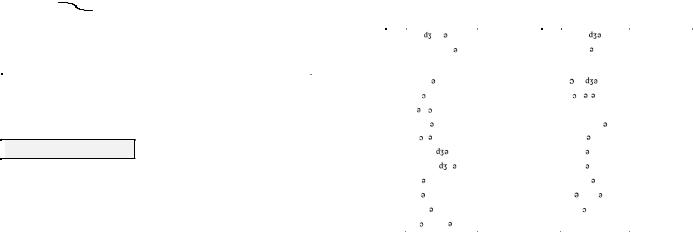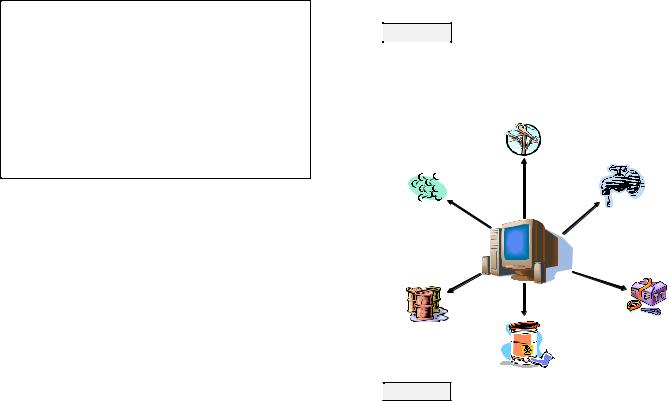
Learning to learn in English
.pdf
using hydrogen-powered buses
a Climate Change Action
Plan
helps to reduce
...........................
|
water heaters powered by |
|
............. |
China |
............... Dongtan |
|
|
|
the Masdar City project |
What do you think?
Do you think ‘green’ initiatives will become popular all over the world? Why?/Why not?
What is an eco-city? Would you like to live in such a place?
Have you ever participated in any ‘green’ activity?
Do you think such initiatives can help to improve the community?
 Speaking
Speaking
Interview ten of your fellow students about the most serious environmental problems in your hometown. How different are their opinions? Discuss your findings as a class. Use the phrases from the Tool box.
Tool box: Presenting another point of view
Some of the people think that …
Each of the interviewees believes that … Most of the people agree/disagree that … Hardly anybody/Nobody feels that … According to the majority of people … Two of ten interviewees say …
50 % of people point out that…
Very few people/All the people claim that … etc.
 Writing
Writing
Complete the bar chart below marking each bar with the results of your interviews. Summarize your findings in a paragraph.
 Reading
Reading
1.Do you know what a greenhouse is? What do we use it for? What is the Greenhouse effect and how is it related to global warming?
2.Work in groups. Brainstorm ideas about global warming: signs, causes and consequences. Discuss your ideas as a class.
3.Before you read the text match each word in A with its definition in B.
A |
B |
1)amount |
a) to send out sth such as light, heat, etc. |
2)effect |
b) to have an influence on sb/sth |
3)emit |
c) a layer of a substance that has formed naturally |
|
underground |
4)simultaneously |
d) a result, influence of sth that has happened: |
5)deposit |
e) a quantity of smth |
6)evident |
f) happening or done at the same time as sth else |
7)delay |
g) a result, influence |
140 |
141 |

8)affect |
h) a substance added to soil to make plants grow |
|
|
|
more successfully |
9)consequence |
i) |
clear, easily seen |
10) fertilizer |
j) |
a period of time, an interval |
4.There are some well-known facts as well as myths about the problem of global warming. Match each myth with the right fact below.
GlobalWarming: Facts vs. myths
MYTHS:
c) Human activities contribute only a small fraction of carbon dioxide emissions, an amount too small to have a significant effect on climate, particularly since the oceans absorb most of the extra carbon dioxide emissions.
d) The warming cannot be due to greenhouse gases,  since changes in temperature and changes in greenhouse gas emissions over the past
since changes in temperature and changes in greenhouse gas emissions over the past  century did not occur simultaneously.
century did not occur simultaneously.
b): Even if the Earth is warming, we can't be sure how much, if any, of the warming is caused by human activities.
a) The buildup of carbon dioxide will lead to a "greening" of the Earth because plants can utilize  the extra carbon dioxide to speed their growth.
the extra carbon dioxide to speed their growth.
e) Carbon dioxide is removed from the atmosphere fairly quickly, so if global warming turns out to be a problem, we can wait to take action to reduce greenhouse gas emissions until we see the impacts of warming.
FACTS:
1. Over millionsofyears, animalsand plantslived,died andwere compressed to form huge deposits of oil, gas and coal. In little more than 300 years, however, we have burned a large amount of this storehouse of carbon to supply energy. Today, the by-products of fossil fuel use – billions of tons of carbon (in the form of carbon dioxide), methane, and other greenhouse gases – form a blanket around the Earth, trapping heat from the sun, raising temperatures on the ground, and steadily changing our climate.
2. The slow heating of the oceans creates a significant delay between the time when carbon dioxide and other greenhouse gases are emitted into the atmosphere and the moment when changes in temperature occur. This is one of the main reasons why we don’t see changes in temperature at the same time as changes in greenhouse gas emissions. In addition, there are manyother factorsthataffect year-to-year variationintheEarth’stemperature such as volcanic eruptions, etc. Still, scientific evidence points clearly to anthropogenic (i.e. human-made) greenhouse gases as the main reason for climate change.
3.Carbon dioxide, a gas created by the burning of fossil fuels (like gasoline and coal), is the most important human-made greenhouse gas. Carbon dioxide from fossil fuel use is produced in huge quantities and can stay in the atmosphere for as long as 200 years. Thus we need to act now if we want to avoid the increasingly dangerous consequencesofclimatechange inthe future.
4.Before human activities began to dramatically increase carbon dioxide levels in the atmosphere, the amount of carbon dioxide emitted from natural sources closely matched the amount that was absorbed through natural processes, for example, through photosynthesis. Some carbon is later released back to the atmosphere. This balance has now been upset by human activities, which since the Industrial Revolution, have put twice as much carbon dioxide into the atmosphere than can be naturally removed by the oceans and forests. This has resulted in carbon dioxide levels higher than they have been in the last 420,000 years.
5.Carbon dioxide can act as a fertilizer for some plant species under some conditions. However, in nature, plant nutrients like nitrogen as well as
142 |
143 |

water are often in short supply. Thus, even if plantshave extra carbon dioxide available, their growth might be limited by a lack of water and nutrients. Finally, climate change itself could lead to decreased plant growth in many areas because of increased drought, flooding and heat waves.
(Adapted from IPCC, 2001. Climate Change 2001: The Scientific Basis)
Comprehension check
1. Here are some answers. What are the questions?
Example: Q: What forms a blanket around the planet?
A: The by-products of fossil fuel use – carbon dioxide, methane and other greenhouse gases.
a)________________________________________________________? The melting of glaciers, warming of oceans, heavy rainfalls and droughts.
b)________________________________________________________? Human-made greenhouse gases.
c)________________________________________________________? For as long as 200 years.
d)________________________________________________________? Through photosynthesis.
e)________________________________________________________? Significant warming in the next century.
f)________________________________________________________? Lack of water and nutrients.
Focus on language
1.Read the sentences and study the models in the box.
Acid rain is strongly acidic rain that …
Soil naturally contains many metallic ions …
We need to act now if we want to avoid the increasingly dangerous consequences of climate change in the future.
Adverb Collocations
Adverbs often go with certain verbs and adjectives. Look at the examples below:
|
Verb + adverb |
|
Adverb + adjective |
|
|
to think quickly |
|
severely damaged |
|
|
to remember well |
|
unusually fast |
|
|
to damage severely/ badly |
|
badly organized |
|
|
to speak confidently |
|
totally destroyed |
|
|
|
|
|
|
Practice
1. Complete the sentences with an adverb from the box.
perfectly |
clearly |
badly |
fully |
desperately |
efficiently |
environmentally-friendly |
|
definitely |
|
extremely |
commonly |
highly |
|
|
|
|
|
|
|
a) The possible impacts of climate change are more ………. understood now.
b)Cotton production will be ………. affected by droughts.
c)There is ………. something wrong with this thermometer, it can’t be that hot!
d)Animals ………. need protection.
e)We are ………. informed about the consequences of global warming.
f)I work with a ………. -motivated team of researchers.
g)People should buy ………. products.
h)Nuclear power plants produce ……… large amounts of electricity. i) Today, our most ………. used types of fuels are oil, gas and coal.
2. Make up 3 – 5 sentences of your own using the adverb collocations from the grammar box.
 Get real
Get real
Search the Internet, specialized magazines or talk to the experts who work in your university to get comprehensive and reliable information about one of the environmental problems typical for your country or the region you live in. Summarize the information you have collected and report back to the class. Follow the guidelines:
State the problem briefly but clearly
Describe the problem in detail
Give examples of causes and effects of the problem.
144 |
145 |

 Speaking
Speaking
Work in groups of 3–4 and discuss what actions as individuals you can take to help to solve the environmental problems listed below. Brainstorm solutions to some national or local problems. Use the phrases from the Tool box. Share your solutions with the rest of the class.
What can be done… a) to control the cutting down of forests?
b)to clean up the beaches?
c)to reduce air pollution?
d)to save rare animals and plants?
e)to slow down global warming?
f)to stop the spread of droughts?
Tool box: Making suggestions
Well, one thing to do is…
Another thing to be done is …
Another way to help is…
If we don’t do …, we will (won’t) …
It would be great to …
We should …
We’d better( do sth.)…

 Writing
Writing
A big petroleum company has announced that it wishes to build a plant to refine petroleum products in the countryside area near your city. This plan has divided the community into three groups:
Greens:
You regard the chosen site as an area of outstanding natural beauty which should not be harmed in any way. You oppose any construction on the site.
Enthusiasts:
You welcome the economic benefits that the new plant will bring and aim to provide technological and financial support which will help the refinery to reduce its impact on the environment.
Regulators:
You would like to strengthen the rules on pollution and increase the fines on companies that release pollutants.
1.Which group do you associate yourself with?
2.Write a letter to the local authorities of your own city giving your opinion on this problem and saying which suggestions you agree or disagree with. Follow the model.
Your address and the date
Name and address of the company/person you are writing to
Salutation
If you know the name of the person, put it:
Dear Mr. Wright Dear Mrs. Wright
If not, put:
Dear Sir(s), Madam
The body of the letter Paragraph 1. The introduction
Say who you are
Say why you are writing
Paragraph 2. The message
Say which
6345 Willow Avenue
Baltimore, Mariland 21220
4 November 2010
Mr. Charles H.C. Wright
City Hall
Special Projects Officer
19 Harbor Place
Baltimore, Mariland 21220
Dear Mr Wright,
I am writing to express my concern about ...________________
____________________________________________________
____________________________________________________
I strongly disagree with ..._______________________________
____________________________________________________
____________________________________________________
In my opinion ....______________________________________
____________________________________________________
146 |
147 |

|
suggestions you |
____________________________________________________ |
|
|
agree or disagree |
____________________________________________________ |
|
|
with |
|
|
|
Give your |
|
|
|
reasons |
I hope you ..._________________________________________ |
|
Paragraph 3. The |
____________________________________________________ |
||
conclusion |
|||
____________________________________________________ |
|||
|
Make any |
||
|
different |
|
|
|
suggestions of |
Thank you for your attention to this matter._________________ |
|
|
your own |
||
|
|
||
Signature: |
Yours sincerely, |
||
If you start: Dear Sir, |
Janette Grayston |
||
Finish:Yoursfaithfully |
|
||
If you start: |
|
||
Dear Mr. Wright |
|
||
Finish: Yours |
|
||
sincerely |
|
||
3. Work in pairs. Exchange your letters and read them. Is the language used by your fellow student appropriate for a formal letter? Are his/her ideas and viewpoints clear? Make any suggestions for improvements.

 In the Realm of Science
In the Realm of Science
1. Practice reading these compounds and chemical reactions.
H2O
HNO3
NOx SO2
C + O2 CO2
[‘eit ‘tu: ou] [‘et ‘en ‘ou ‘Θri] [‘en ‘ou ‘eks] [‘es ‘ou ‘tu:]
[si:plus ou tu: givesi: out u:]
C plus O two give CO2 1 atom of carbon reacts with 1 two-atommolecule ofoxygen and produces 1 moleculeof carbon dioxide
2.Now take turns to read and note down the following compounds and chemical reactions.
Student A: H2CO3 |
P2O5 |
Na2O |
CaCo3 |
H2SO4 |
K3Po3 |
HgO |
Student B: H2SO4 |
H3PO4 |
MgO |
ZnSO4 |
NaCL |
CuO |
NaNO2 |
2Mg+O2 2MgО CaO+H2O Ca(OH)2 2CO+O2 2CO2
NaCl + AgNO3 NaNO3 + AgCl
3. Learn the pronunciation and the meaning of the main chemical elements.
Ag |
[α: ent m] |
argentum |
N |
[ naitri |
n] |
nitrogen |
|
Al |
[,ælju minj m] |
aluminium |
Na |
[ soudj m] |
sodium |
||
Br |
[ broumi:n] |
bromine |
Ni |
[ nikl] |
|
nickel |
|
C |
[ kα:b n] |
|
carbon |
O |
[ ksi n] |
oxygen |
|
|
|||||||
Cl |
[ kl :ri:n] |
|
chlorine |
P |
[ f sf r s] |
phosphorous |
|
Co |
[k b :lt] |
|
cobalt |
Pb |
[led] |
|
lead |
|
|
||||||
Cs |
[ si:zj m] |
|
caesium |
Pu |
[plu: tounj m] |
plutonium |
|
Cu |
[ k p ] |
|
copper |
Ra |
[ reidj m] |
|
radium |
H |
[ haidri |
n] |
hydrogen |
S |
[ sΛlf ] |
|
sulfur |
|
|||||||
Hg |
[haidrα: |
ir m] |
hydrargyrum |
Si |
[ silik n] |
|
silicon |
|
|||||||
|
[ m :kjuri] |
mercury |
Ti |
[ti teinj m] |
titanium |
||
|
|||||||
I |
[ ai di:n] |
|
iodine |
U |
[ju reinj |
n] |
uranium |
|
|||||||
Li |
[ li i m] |
|
lithium |
Xe |
[ zen n] |
|
xenon |
Mo |
[m libdin m] |
molybdenum |
Zn |
[zi k] |
|
zinc |
|
|
|
|
|
|
|
|
|
148 |
149 |

Unit 1. Progress Monitoring
In this unit you have worked on the following vocabulary related to the topic “Environment”
deforestation
ozone layer depletion vehicle exhausts
the melting of glaciers renewable energy sources a serious issue/grave
conesquences
to improve air quality
the burning of fossil fuels
to cut pollution/contamination levels
Tick (V) thepoints you areconfidentabout andcross (X)theones youneed to revise.
Unit 2 |
CleanTech = GreenTech |
 Lead-in
Lead-in
1.What kind of environmental problems has the computer era already brought about? Make a list of the problems and discuss them with the rest of the class.
2.Look at the picture and make suggestions on what the manufacture of
one PC requires. Comment on the environmental hazards of this process.
 Reading
Reading
1.Read the text. Check if your predictions of the possible environmental hazards correspond to the information in the text.
150 |
151 |

5
10
15
20
25
30
35
Environmental Hazards of the ComputerRevolution
Millions of high technology word processors, home computers, telephones and other electronic equipment are creeping into every
office and children’s bedroom, |
Managing your learning |
|
transforming work and improving |
Some prefixes carry meaning changing |
|
entertainment. |
themeaningoftheword,e.g. |
|
un-, in-, and dis- indicate a negative |
||
Increasingly, however, scientists |
meaning; |
|
are discovering the downside. |
re- means to do again; |
|
sub- has the meaning under; |
||
Researchers have found that they |
||
over- too much, beyond; |
||
are becoming one of the western |
en- indicates a verb formed from |
|
world’s biggest environmental |
an adjective or a noun. |
|
|
||
hazards. |
|
Ase-devices closelyblend metals, glassand several typesofplastic they have been described as a “recycler’s nightmare”. It is cheaper and easier to dump them in landfill sites compromising air and land quality and let future generations worry about the problem. What makes computers and other electronic equipment hazardous? There are numeroushazardous materials in computer equipment, in particular in monitors and terminals. The glass tubes in monitors and televisions, called Cathode Ray Tubes, contain between two-to-five pounds of lead. Computers also contain cadmium and lithium, usually in the batteries of computers. There are also trace elements of mercury. Laptops have fluorescent lamps that create backlight to see image. The lamps contain mercury. They also waste energy. Most PCs are only used for a fraction of the time they are switched on and up to 40 per cent are left on overnight or at weekends.
The manufacturing process uses up valuable resources such as water, and involve highly toxic chemicals such as hydrochloric acid and phosphine, which are used for etching silicon chips in some of Scotland’s microelectronic companies.
Hopefully, all the waste will have to end. The European Industry Council for Electronic Equipment Recycling, which includesthe large computing companies like Hewlett Packard, hasbeen formed to draw up a set of principles for the disposal of computers.
The council’s director admits that the industry does not do enough to encourage recycling and favours incineration for energy production and insists that landfill remains valid in some cases. “We are looking
for solutions that are environmentallysound and commercially realistic.” The Council is trying to encourage manufacturers to redesign their
40products so that they use less energy, cause less pollution and can be more easily recycled. On the other hand, the companies are urged to cut down on the chemicals used in the manufacturing processes.
Environmentalists are convinced that developing more efficient manufacturing processes and standardizing the types of plastic and
45metal used would all help. They urge manufacturers to refurbish and reuse rather than dismantle and recycle old computers. “A lot of companies throw out computers when they are still working in order
to get a more efficient or faster model. Why can’t they be adapted for use in schools and colleges, which are short of computer equipment?”
50asked Madeline Cobbing form the environmental group Greenpeace. She criticizedthe industry forsuggestingincinerationasanalternative. Because of the lethal combination of different metals and plastics,
burningcomputerscould release poisonousdioxinsintothe atmosphere.
(“Scotland on Sunday Essential Articles 3, Carel Press, Carlisle)
Comprehension check
1.Read the text more carefully and answer the questions.
a)What environmental dangers has computer revolution brought about?
b)Why should old electronic equipment be carefully recycled?
c)What practical steps do the environmentalists take to reduce electronic wastes?
d)What is the European Industrial Council for Electronic Equipment Recycling responsible for?
e)What is the other side of incinerating old computers?
f)What possible ways to cope with the e-waste problem do environmentalists suggest?
2.Using the line references given, refer back to the text and find words or phrases that have a similar meaning to:
a)making better (lines 1 – 5)
b)concern about (lines 10 – 15)
c)spend sth carelessly (lines 20 – 25)
d)producers (lines 35 – 40)
e)reduce (lines 40 – 45)
f)recommend (40 – 45)
152 |
153 |

3.Read the sentences and match the words in italics with their meanings from the list below.
a)It is cheaper and easier to dump them in landfill sites to compromise the air and land quality.
b)Researchers have found that computers are becoming one of the world’s biggest environmental hazards.
c)He is trying to convince producers that they should be responsible for reducing their waste without the need for legislation.
d)Why can’t they be adapted for use in schools and colleges, which are desperately short of computer equipment?
e)She criticized the industry for suggesting incineration as an alternative.
f)The Council favours incineration for energy production and insists that landfill remains valid in some cases.
g)The Industry Council for Electronic Equipment Recycling has been formed to draw up a set of principles for the disposal of computers.
1) |
discard |
3) dangers |
5) throw out |
7) burning |
2) |
supports |
4) lack for |
6) persuade |
|
Focus on Language
1.Complete the table. Make nouns from the verbs given in the table by adding suffixes –tion, -ment or -ing. Consult a dictionary if necessary.
VERB |
NOUN |
to recycle to generate to pollute to encourage to combine to introduce to develop to require to produce to equip
2.Work in teamsofthree. Make asmany wordsas possible usingthe prefixes re-, dis-, over-, sub-, en-, up- . Compare as a class.
cover |
load |
connect |
assemblies |
large |
source |
grade |
play |
cycle |
able |
courage |
furbish |
night |
mantle |
scribe |
come |
|
|
3.Study the sentences in the box and make rules.
Highly toxic chemicals are used for etching silicon chips in some microelectronic companies.
Why can’t they be adapted for use in schools and colleges?
Manufacturers redesign their products so that they can be more easily recycled.
The ICEER has been formed to draw up a set of principles for the disposal of computers.
A lot of companies throw out computers when they are still working in order to get a more efficient or faster model.
Expressing purposewith to, in order (not) to, so that and for
To express purpose
We use to and in order (not) to plus an infinitive when the subject of the main clause and the clause of purpose are the same.
In order (not) to is more formal than to .
We can use so that both when the subject of the main clause and the clause of purpose are the same and they are different.
We often use so that with can, could or other modal verbs and the main verb.
We use for with a noun or a gerund.
Practice
1. Match two halves to make sentences.
1) |
Many electronics recyclers simply |
a) |
so that they won’t explode |
|
collect equipment and do initial |
|
scattering shards of glass |
|
disassembly, then contract with |
|
and other materials. |
|
others |
|
|
2) |
Most recyclers charge fees |
b) |
to protect our environment. |
3) |
About 50 percent or more of the |
c) |
in order to determine the |
|
United States' used computers, |
|
measures necessary to |
|
cellphones and TVs sent to |
|
achieve reduce greenhouse |
|
recyclers are shipped overseas |
|
gas emissions by 6%. |
154 |
155 |

4) |
A reasonably new computer should |
d) |
to build a new incinerator |
|
be refurbished |
|
in an area of countryside |
5) |
Cathode ray tube (CRT) monitors, |
|
near our city. |
|
should be disposed properly |
e) |
to process equipment. |
6) |
We must create ways to recycle |
f) |
for materials recovery. |
7) |
Make sure the reuse organization is |
g) |
for recycling. |
|
accepting donations |
|
|
8) |
The Kyoto Protocol Target |
h) |
so that its owner could sell |
|
Achievement Plan was established |
|
at nearly give-away prices. |
9) |
I am strongly against the |
i) |
for local reuse, and not |
|
government’s plans |
|
sending them overseas. |
 Get real
Get real
What do you or your friends usually do with your old electronic devices? Ask your fellow students, teachers and parents what they would do with their computers when they don’t meet their needs. Take notes of the answers and report back on 10 most popular ideas.
 Speaking
Speaking
Tool box: Expressing opinion
In our opinion …
First of all, …/ Then, …/Next, … Moreover, …
Furthermore, …
The greatest advantage of … The disadvantage of this way is
that …
To sum up, … In conclusion, …
Work in groups of 4 – 5. Suggest and discuss any other means that can reduce hazardous effect of the computer revolution. Share your ideas with the rest of the class. Explain pros and cons of the suggested solutions.
 Listening
Listening
1.Listen to the interview with an electronic waste expert John Shegerian and take notes to answer the questions.
a)What is “electronic waste” (e-waste)?
b)Why is e-waste a growing concern?
c)Why should people recycle their e-waste?
d)How much of the solid waste in landfills is e-waste?
e)Is it illegal to dispose of computers in the trash?
f)How long has e-waste recycling been around?
g)Who started the e-waste recycling movement?
h)What percentage of electronics today is being recycled properly?
2. Listen to the interview again and fill in the notes.
Electronic waste is the fastest growing…1……… stream in the world. It includes everything electronic: from our …2………., to our IPods, to …3
……….. and …4…………., …5……………, and our copiers and …6
…………… . Everything electronic encompasses …7…………… . E-waste has lots of …8………… and …9………… materials in it, such as lead, mercury, cadmium, and beryllium. If these items end up in our… 10…………, and then leech into our ground and water supplies, they tend to …11……………our environment to the point where it is then ingested by a human being or animals. We want …12………………… that. …
We should recycle e-waste because …13……………to recycle. You get back to an appropriate …14…………. or recycler who will demount the factors of the materials to …15……………, metals and …16…………………… . Also, everything in your cell phone or your television set is …17……………….., and reuses the essence of …18…………………. . …
In California, for example, today it's …19……………….. to throw out your computers or e-waste into the …20…………….. . Other states and other countries are yet to…21………………with California's leading recycling laws. …
It's …22………….. who really started the e-waste recycling movement, but there're lots of …23……………groups and people out there that saw what was coming and saw the growing trend with technology and the fast turnover that we have now with technology. At the international level, e- waste recycling has been around, …24……………., when Switzerland and some European countries started passing initiatives. …
InCalifornia,they…25………….thelandmarkSB20lawin…26……….. That law just got …27………….on January 1, 2005. So e-waste aswe know it in the United States is a growing trend that has been…28…… only since 2003, and …20……………….. since …30……….. .
156 |
157 |


 Reading
Reading
1.The verbs in A are in the text you are going to read. Match a verb in A with a definition in B.
A |
B |
1) demanufacture |
a) to restore smth to good condition that is |
|
broken, damaged or torn |
2) break down |
b) to bring smth back to a former condition |
3) donate |
c) to repair and clean a device in order to make it |
|
more attractive, like new |
4) refurbish |
d) to treat substances or devices with chemicals |
|
in order to separate raw materials |
5) repair |
e) to destroy or divide smth into parts in order to |
|
analyze it or make it easier to do |
6) restore |
f) to take goods to pieces in large quantities using |
|
machinery |
7) reuse |
g) to treat things that have already been used so |
|
that they can be used again |
8) recycle |
h) to use smth again |
9) process |
i) to give money, food, clothes, etc. to sb/sth, |
|
especially a charity |
2. Read the text on the work of electronic waste recycling and complete the diagrame of the recycling process below.
As much as we love gadgets, a lot of us don't know nearly enough about how to dispose ofthemproperly(inanenvironmentfriendly manner). What makes high tech
trash such a problem is that each piece of equipment contains numerous toxic and hazardous materials: heavy metals – including lead, cadmium, chromium, and mercury – and many synthetic chemicals that are persistent pollutants that linger in the atmosphere for years and accumulate in animals and people where they cause serious health problems. These toxics are released when equipment is damaged, destroyed or improperly disposed of - and that's what happens to a huge amount of our old electronics.
Some used computer/electronic materials can be recycled or reused instead of landfilled. There are four main types of electronic recyclers, and some recyclers perform multiple functions as collectors, refurbishers, demanufacturers and processors.
Collectors accept electronics from businesses and the general public. Collected material is then shipped to a refurbisher, demanufacturer or processor. There are two main types of collectors: those affiliated with a permanent drop-off site, and those operating from a temporary location set up for a special collection event.
Refurbishers include nonand for-profit organizations that accept, sort and refurbishused computer equipment. Reparable productsare either resold or donated after they are restored to working condition; nonreparable components are sent to a demanufacturer or processor.
Demanufacturers accept used computer equipment and broken-down computer components. Parts are then further broken down into pieces such as plastic housings, wires, metals and circuit boards. Demanufacturers then send these parts to smelters or processors that have the equipment and facilities to process these components.
Processorsaccept demanufactured electronic components and break them down to their raw materials. Processing may also include resource recovery procedures such as precious metal separation, lead smelting and waste-to- energy incineration. Processing is the last stage of recycling before final disposition.
The biggest economic incentive behind electronics recycling is the recovery of metals – including precious metals, silver, gold and even platinum. Metals make up over half of the weight in many computers, particularly the older ones now being discarded. These computers also contain quite a lot of copper which is in great demand right now, and commands high prices. It wasmining companies who first got into electronic recycling business because they figured out it was a lot more profitable and predictable - to 'mine' old circuit boardsthan it would be to prospect for the same amount of ore and metal in new mines. Apile of old circuit boards has a greater concentrationofgold, forexample, thandoesthe equivalent amount of ore. But current recycling rates mean that we're simply throwing away about 90 percent of the billions of pounds of copper and millions of pounds of gold that are in our obsolete computer equipment - copper and gold that is essentially 100% reusable. So there isa lot of money to be made in selling
158 |
159 |
